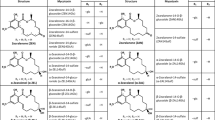Abstract
Fusarium toxins are of great practical relevance in animal feeding since they may occur in toxicologically relevant concentrations. Therefore, many attempts have been made to search for detoxification of contaminated feedstuffs or diets in order to cope with the problem. The supplementation of contaminated diets with detoxifying agents seems to be most feasible, andin vitro results seem to be convincing.
According to the Guideline 87/153/EEC, the efficacy has to be proven by using an experimental design justified according to the claim for the use of the additive. Reviewing the literature, only a few studies investigated specific parameters which may clearly reflect the claimed mode of action of the additives, and those demonstrated no measurable detoxifying effects. The majority of investigations focused on the rather non-specific performance parameters, while many of these applied incomplete experimental designs. Nevertheless, most of the experiments did not demonstrate preventative effects.
It is concluded that testing of currently available detoxifying agents did not follow the Council Directive since the claim for their use was not proven.
The application of complete two by two factorial experimental designs, the investigation of mycotoxins and/or metabolites in physiological samples as specific parameters and the verification of the specificity of the detoxifying agent is recommended for futurein vivo investigations.
Similar content being viewed by others
References
BML (2000) The German Federal Ministry of Agriculture: Orientation values for critical concentrations of deoxynivalenol and zearalenone in diets for pigs, ruminants and gallinaceous poultry. VDM 27/00: 2–3
Oldenburg E, Valenta H and Sator Ch (2000) Risikoabschätzung und Vermeidungsstrategien bei der Futtermittelerzeugung. In: Dänicke S und Oldenburg E (Eds.) Risikofaktoren für die Fusariumtoxinbildung und Vermeidungsstrategien bei der Futtermittelerzeugung und Fütterung. Landbauforsch. Völk., Sonderheft Nr. 216, pp. 5–34
Ramos AJ and Hernandez E (1997) Prevention of aflatoxicosis in farm animals by means of hydrated sodium calcium aluminosilicate addition to feedstuffs: a review. Animal Feed Science and Technology 65: 197–206
Author information
Authors and Affiliations
Rights and permissions
About this article
Cite this article
Döll, S., Dänicke, S. On the efficacy of detoxifying agents in the prevention of fusariotoxicoses — A critical evaluation of the situation. Mycotox Res 19, 185–189 (2003). https://doi.org/10.1007/BF02942962
Issue Date:
DOI: https://doi.org/10.1007/BF02942962




